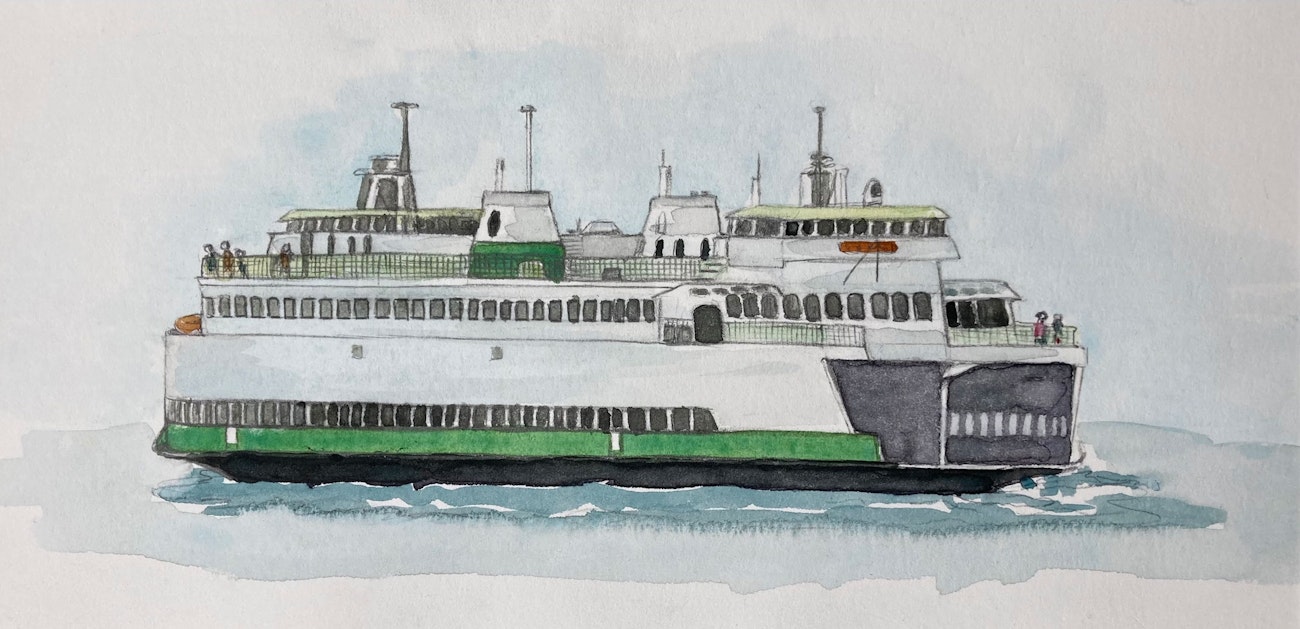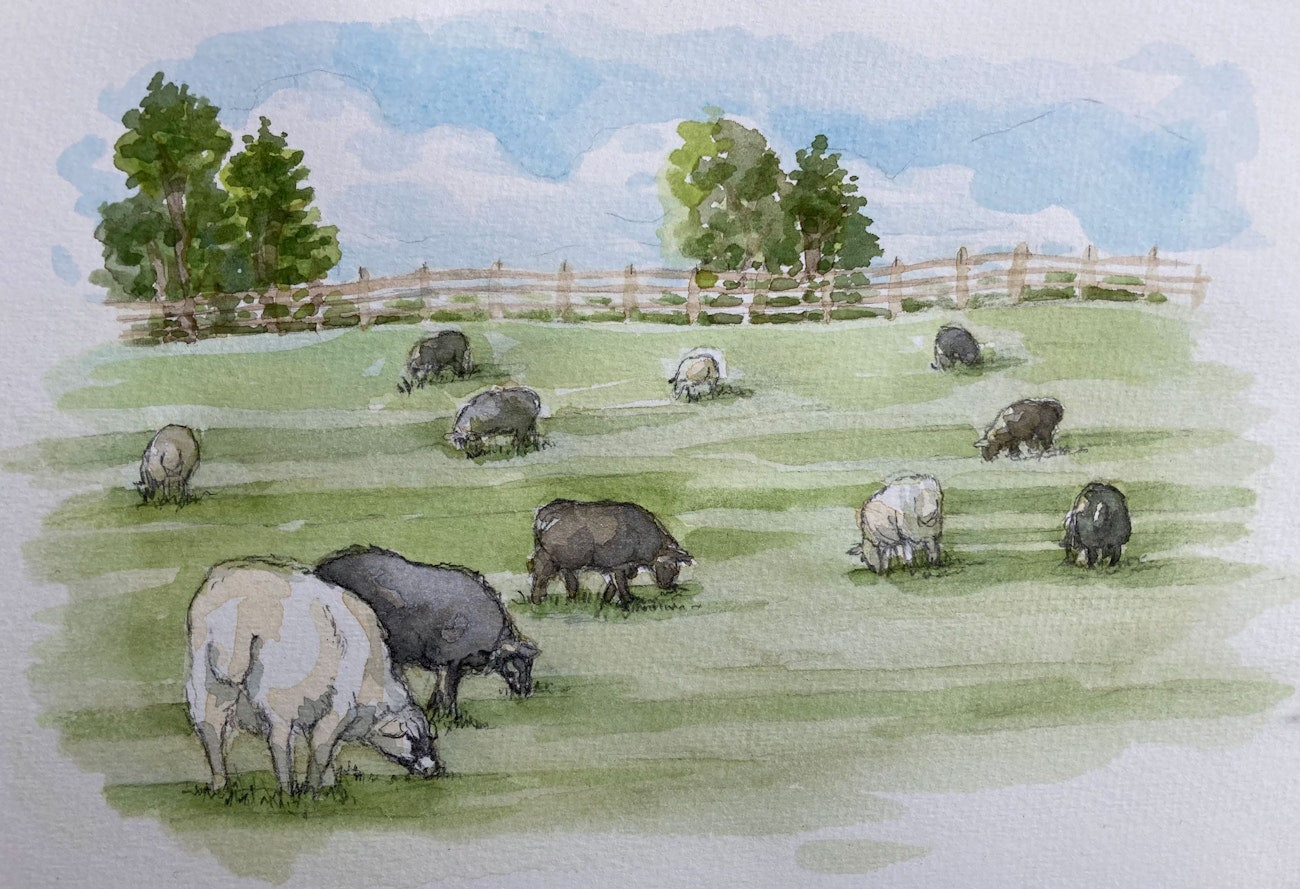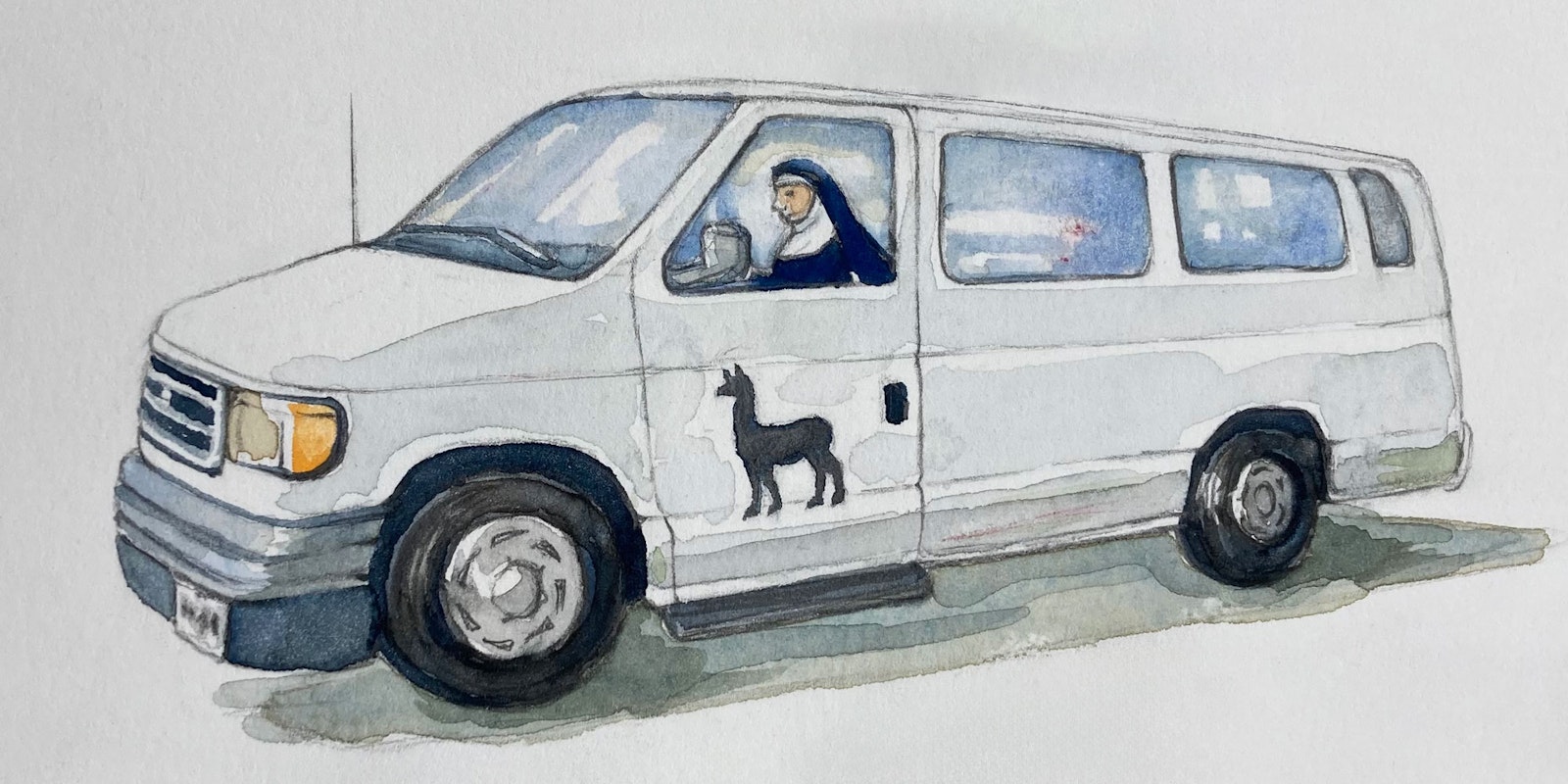https://farmfiberknits.com/cdn-cgi/image/format=auto/https://www.datocms-assets.com/101500/1702678180-strawn-white-van-mh.jpg?auto=format&w=900
Shaw Island, the San Juan Islands, Washington, 2003.
I traveled to Shaw Island intending to meet the nuns who raised sheep for the wool yarn I had bought a year earlier in Friday Harbor. A quick online search showed that the nuns were a well-known sight at the ferry terminal. Photos showed them operating massive hydraulic ramps that loaded and unloaded passengers and cars from the ferry dock.
I had squeezed in a flight to Seattle from Iowa, where I was immersed in graduate study of textiles and facing preliminary exams. American graduate school retained a whiff of the Medieval university: one make-or-break exam followed years of reading and study. Stressful? Oh, yes. Traveling to meet the nuns and their sheep on Shaw Island seemed as good a way as any to settle my mind before the exams.
My friend Judy and I drove north from Seattle, left our car in Anacortes, and walked onto one of the Washington State ferries. Riding the ferry thrilled me. I had been landlocked in Iowa for two years. Judy and I walked off the ferry at Shaw Island, and a nun wearing a fluorescent orange safety vest over her long brown habit greeted us. We followed her brisk walk to the nearby Little Portion Store.
The nuns had purchased the store in 1976 and named it for the Italian church Portiuncula from the place where St. Francis of Assisi lived and died. The store seemed the only nod to tourism and the practical needs of boaters and the island’s 150 or so year-round residents. Inside were shelves filled with groceries and household items.
“I’m looking for yarn, and I’d like to see the sheep,” I told the nun, who had by then become the shopkeeper. “Last summer in Friday Harbor, I bought wool yarn spun from sheep on Shaw Island. Is your flock nearby?”
“Oh, I am sorry,” she said. “You want the Benedictines. We’re Franciscans. We just run the store and ferry terminal.” How modest. She was one of four Franciscan Sisters of the Eucharist, all in their 60s and 70s, who also ran the post office and a preschool, taught computer classes, and directed musical performances. [PAYWALL] Only one year later, with no new recruits to the order and weary of 16-hour days, the Franciscans would sell the store and move off the island.
 Washington State ferries connect four of the San Juan Islands—Lopez, Orcas, San Juan, and Shaw—with mainland Washington.
Washington State ferries connect four of the San Juan Islands—Lopez, Orcas, San Juan, and Shaw—with mainland Washington.
“The Benedictines at Our Lady of the Rock Monastery raise sheep and llamas. The monastery is about four miles that way.” She pointed toward a narrow road leading into the imposing Pacific Northwest woods.
I was ready to walk four miles to the monastery, but Judy was having none of that.
“Are there cars to rent?” I asked. “A taxi? Bicycles?” There were not.
Judy scowled. She dug in her heels, perched on a picnic table outside Little Portion, and checked the return schedule for the ferry. Have I mentioned Judy was not a knitter or spinner?
“Maybe you can get a ride,” the nun said. “Mother Hildegard from the Monastery usually comes in to pick up the mail about now. Not every day, but maybe today. You could wait and ask her.”
Questionable Transportation
Within minutes, a white van with a silhouette of a llama on the driver’s side door barreled in from the road and parked at the store. The driver—a substantial woman with an air of authority—bustled toward Little Portion. She wore a long black and white habit, not brown.
“Look!” I pointed to the van and shook Judy’s shoulder. “There’s our ride . . . maybe.”
I lingered near the van until the driver emerged with a handful of mail.
“Mother Hildegard?” I asked. “I came here from Iowa to see the sheep on Shaw Island.”
My story about buying Shaw Island yarn and my confusion between Franciscans and Benedictines tumbled from me. “The nun in the shop said you might give us a ride to your monastery.”
She hesitated, perhaps puzzled by such a clueless visitor.
“Okay, I can give you a ride there,” she said. “But I can’t guarantee I’ll have time to bring you back.”
“Not a problem,” I said. Judy cast me a worried glance.
“I need to post these 4-H results first,” she told us. “We had the San Juan County Fair last weekend and our kids from Shaw did well.” Mother Hildegard tacked her 4-H announcement onto a community bulletin board and, just like that, Judy and I were in her van and on our way.
Two miles down the road from the ferry terminal, the van shuddered to a halt.
Words, angry and sudden, burst from Mother Hildegard.
Judy and I caught one another’s eye, stunned to silence. A glance between us said, Did you hear what she said? What happens when a nun swears? Lightning bolt? Earth tremors? This was uncharted territory in land at risk for earthquakes.
Mother Hildegard stared hard at the dashboard of her errant van.
“I bought this van from Navy surplus. It cost me $700 to have it fixed up. Last month I drove it 80 miles an hour across I-90 to deliver a llama to South Dakota. It was fine all the way.”
She held out her hand to Judy, “Give me your phone.”
Judy scrabbled in her bag for her mobile phone and handed it over.
“No connection,” said Mother Hildegard. I dug my phone out of my backpack and passed it to her from the back seat. Again, nothing.
“These things don’t work out here,” she said and handed the phone back to me. We sat in silence on the lonely road. I felt the shadowy trees, tall and dark, begin to close in above me. Sunlight streamed through the high branches. I was not in Iowa’s wide-open skies and cornfields anymore.
Mother Hildegard sighed deeply. Then she turned the key in the ignition. The engine obeyed and blew life back into the van with a loud whoosh and bit of smoke out the tailpipe. We continued our drive through the woods, the van’s misbehavior forgotten, perhaps forgiven.
Our Lady of the Rock at Last
I remember the monastery’s retreat house surrounded by woods and pastures as plain and pleasant, with the welcoming feel of a farmhouse. The Benedictines, a contemplative and semi-cloistered order, had founded the monastery on 300 acres of forest and farmland in 1977. They raised sheep, llamas, chickens, flowers, and vegetables for themselves and to sell. The monastery aimed to be self-sustaining. Mother Hildegard led us to a room with baskets of wool. The natural colors of fleece, especially a deep black llama fleece, drew me in.
Judy was polite but looked unimpressed.
“One of our patrons was a world traveler,” said Mother Hildegard, pointing toward a stash of clear plastic bins. “She collected beads and thought we could make jewelry to sell.” Judy, an avid jewelry designer, perked right up. Thrilled to bits, she dived into the impressive variety of beads. Before long, Judy and Mother Hildegard were huddled head-to-head, holding up glass and clay beads, chatting about ideas for jewelry.
Our enthusiasm won over Mother Hildegard. She drove us back to the ferry past the island’s library, museum, and the Little Red Schoolhouse (kindergarten through eighth grade) in continuous use since 1891. She pointed out the monastery’s scattered flock of 30 or so Cotswold sheep that dotted a pasture. Wooly little heads with curly bangs popped up as the van drove slowly past.
“We raise Cotswolds because they do so well in our climate, like where they originated in England,” she said. “Cotswolds are hardy, very low maintenance. I asked my father for the first pair as a Christmas gift and started our breeding line with them. The natural colors are worth more than the white.”
“That yarn from your wool that I bought last year was lovely,” I told her. “Great loft and luster, a pleasure to knit. I knitted hats.”

Mother Hildegard decided to breed for color in her Cotswold sheep.
Parked outside the Little Portion Store, Mother Hildegard chatted with Judy while I went inside and looked for souvenirs. I returned to thank Mother Hildegard before we caught the ferry.
“Your friend tells me you are taking your written prelims soon,” she said.
“Yes, I am. And this time away relaxed my mind. No better way to prepare.”
“We’ll pray for you,” she said.
Eight Benedictine nuns at Our Lady of the Rock Monastery on Shaw Island, 2,000 miles from Iowa, would be with me in spirit! Years later, I learned that Mother Hildegard understood: she holds a Ph.D. in child and adolescent psychology. Her research and clinical work, writing, and lectures have focused on animal-assisted therapy.
Aboard the ferry back to Anacortes, I leaned against the deck railing and turned my face to the sun, savoring the blend of warmth with a cool breeze off the water. Seagulls screeched and dived above me. I would carry back to Iowa every nourishing sensation.
I passed preliminary written and oral exams, and a year and half later, defended my dissertation. I moved on to a tenure-track teaching position at Dominican University in Chicago—never a trivial thing to land a position teaching textile science and historical/cultural dress—and taught for ten years in the company of Dominican Sisters, the Order of Preachers.
I like to think that Mother Hildegard of Our Lady of the Rock Monastery was with me every step of the way.
Cotswold sheep still graze the pastures at the monastery on Shaw Island, tended by Mother Hildegard and other Benedictine Sisters. You can visit Our Lady of the Rock Monastery online.
Susan Strawn researches, writes, and illustrates cultural histories of textiles and textile makers, with a special interest in the history of American knitting. She is a former staff artist at Interweave Press, contributing editor to PieceWork magazine, Professor Emerita of Apparel Design and Merchandising at Dominican University (Chicago), and author of Knitting America: A Glorious History from Warm Socks to High Art (St. Paul, Minnesota: Voyageur Press, 2007). She makes her home on Bainbridge Island, Washington.


 Washington State ferries connect four of the San Juan Islands—Lopez, Orcas, San Juan, and Shaw—with mainland Washington.
Washington State ferries connect four of the San Juan Islands—Lopez, Orcas, San Juan, and Shaw—with mainland Washington.